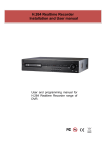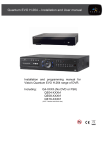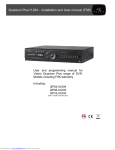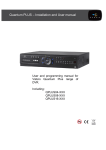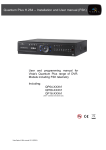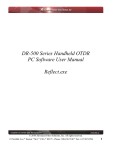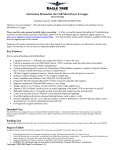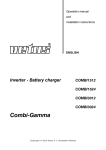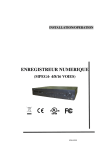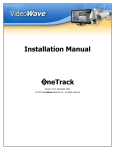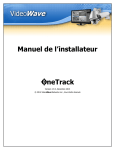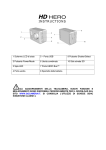Download H.264 Realtime Recorder Installation and User manual
Transcript
H.264 Realtime Recorder Installation and User manual User and programming manual for H.264 Realtime Recorder range of DVR. H.264 Realtime Recorder Installation User Manual This page is intentionally left blank 2 H.264 Realtime Recorder Installation User Manual CE INFORMATION The product must be installed according to the currently valid installation regulations for EMC to guarantee the designed use and to prevent EMC problems. The device supplied with this manual is according to the EC, EMC Directive, 89/336/EEC & LVD 73/23/EEC Standard used for showing compliance with the essential requirements of the device: EN 55022 EN 61000-3-2 EN 61000-3-3 EN 50130-4 EN 55024 LVD: EN60950-1 ELECTRICAL SAFETY Explanation of electrical safety symbols 3 H.264 Realtime Recorder Installation User Manual Contents SAFETY PRECAUTIONS ...................................................................................................................................... 6 CONTENTS OF PACKAGING .............................................................................................................................. 7 FEATURES ............................................................................................................................................................... 7 FEATURES ............................................................................................................................................................... 7 FRONT PANEL ........................................................................................................................................................ 9 REAR PANEL CONNECTIONS.......................................................................................................................... 12 SYSTEM CONNECTION DIAGRAM................................................................................................................ 13 REMOTE CONTROL ........................................................................................................................................... 14 OSD DESCRIPTION ............................................................................................................................................. 15 MENU TREE .......................................................................................................................................................... 16 DEFAULT PASSWORDS ...................................................................................................................................... 18 MENU NAVIGATION ........................................................................................................................................... 19 MENU SETTINGS ................................................................................................................................................. 21 1 .DISPLAY ....................................................................................................................................................... 21 2. RECORDING ................................................................................................................................................ 25 3. SYSTEM ....................................................................................................................................................... 33 Disk Format ....................................................................................................................................................... 36 ACCOUNT ........................................................................................................................................................ 37 Program Update ................................................................................................................................................ 38 SENSOR ........................................................................................................................................................... 39 PTZ Setup ......................................................................................................................................................... 39 PTZ Controller ................................................................................................................................................... 40 4. NETWORK .................................................................................................................................................... 43 5. Event ............................................................................................................................................................. 46 SEARCHING VIDEO FOOTAGE ...................................................................................................................... 50 Archiving Evidence to DVD/CD or USB............................................................................................................ 53 LOG ................................................................................................................................................................... 55 CLIENT VIEWER SOFTWARE – DDVR4000 ................................................................................................. 56 LOG IN .............................................................................................................................................................. 57 Explanation of Screen Buttons ......................................................................................................................... 57 Live Monitoring .................................................................................................................................................. 58 Remote search .................................................................................................................................................. 61 Remote Log ....................................................................................................................................................... 66 Info .................................................................................................................................................................... 66 Remote Setup: Checking settings menu (Same as DVR) ............................................................................... 67 Recording .......................................................................................................................................................... 70 System .............................................................................................................................................................. 77 EVENT .............................................................................................................................................................. 84 Local Search ..................................................................................................................................................... 86 Local Setup ....................................................................................................................................................... 89 PAN, TILT, Zoom, Focus ................................................................................................................................... 91 Firmware Upgrade ............................................................................................................................................ 93 Quit (Stop Client program) ................................................................................................................................ 93 APPENDIX 1........................................................................................................................................................... 94 APPENDIX 2........................................................................................................................................................... 97 APPENDIX 3......................................................................................................................................................... 101 APPENDIX 4......................................................................................................................................................... 104 4 H.264 Realtime Recorder Installation User Manual APPENDIX 5......................................................................................................................................................... 106 APPENDIX 6..........................................................................................................................................................113 5 H.264 Realtime Recorder Installation User Manual SAFETY PRECAUTIONS CAUTION BEFORE USE Please read this manual before installing or using the DVR. Please keep this manual in a safe place, to allow for future reference For the safety and proper use, The DVR is marked with various symbols. Please read these to prevent injury of financial loss. INSTALLATION SITE Ensure installation position is level, secure and adequately ventilated. Avoid installing close to sources of humidity or water. 6 H.264 Realtime Recorder Installation User Manual CONTENTS OF PACKAGING Digital Video Recorder System Standalone DVR Network CD Please read this manual before using User Manual Power Cable Remote Controller Network CD Battery Mouse 7 H.264 Realtime Recorder Installation User Manual FEATURES ● Convenience - User-friendly GUI (Graphical User Interface) - Easy-to-use menu structure - Easy-to-use recorded data search (Time, Date, Motion, and Alarm) - Easy-to control via Front Panel, IR remote control and USB 2.0 mouse. ● Stability - Auto restart after power interruption - DB structure offers data stabilisation and better storage utilisation ● Expandability - Remote DVR’s can be controlled using the supplied software client viewer. ● Technology -Embedded LINUX OS -Maximum record rate 400 fps -High-resolution & high-quality H.264 algorithm -Uses watermarking & scrambling technologies, -H.264 : 1 ~ 2 Kbytes per image with resolution 360x240 ● Functionality - Variable recording function (normal, alarm, motion, schedule, audio, duration) - Full channel real-time monitoring - Live monitoring, recording, playback, backup, remote access simultaneously - Multi channel playback - Variable events notification to e-mail, buzzer or PC Client system 8 H.264 Realtime Recorder Installation User Manual FRONT PANEL (1)LED - REC: Recording status (When recording is on, the red light will flash) - POWER: System Power On/Off (When power is on, the green light will be illuminated) - NET: Network status (When network is connected, the light will lash) - HDD: HDD status (When the system is reading or writing to the HDD, the light will flash) (2) USB 2.0 PORT - USB2.0 connector, for downloading to USB pens / drives (upgrading firmware) (3) POWER BUTTON - System Power On/Off (4) NUMERIC & CHARACTER - Input for numbers & letters within the setup menus and searches (5) MENU - Displays the menu on the screen (6) SEARCH - Entering search mode 9 H.264 Realtime Recorder Installation User Manual (7) PLAY ( ) - Playback of the recorded data - When in play mode press again to enter fast forward mode. (8) REWIND ( )W - Reverse play of recorded data - When in play mode press again to enter fast rewind mode. (9) PAUSE ( ▌▌) - To freeze picture on playback mode and live mode. (10) STOP / EJECT ( █ ) - To stop playback and go back to live mode. - To eject DVD-RW (11) REC (●) - It starts & stop manual recording, password protected. (13) ARROW KEY - Moves the cursor while in menu mode (14) SELECT - Menu selection (15) PTZ Selection - PTZ Channel selection 10 H.264 Realtime Recorder Installation User Manual (16) Screen Split - Selection of multi screen functions (18) PAN / TILT - To control P/T/Z, press this button to browse virtual key on screen. (19) ZOOM - ZOOM P/T/Z camera in and out 11 H.264 Realtime Recorder Installation User Manual REAR PANEL CONNECTIONS (1) VIDEO IN (BNC) - 16/8/4 Camera input (1.0v p-p, 75Ω) (2) VIDEO OUT - 16/8/4 LOOP / SPOT / Composite / S-VIDEO / VGA (3) LINE AUDIO INPUT - 16/8/4 Audio input through line (4) AUDIO OUTPUT - 1 Audio output (5) RS232 - 1 Serial Communication (6) Network Port (RJ-45) - Connecting to the Quantum DVR through Internet or LAN (7) USB 2.0 -USB 2.0 connector for mouse control. 12 H.264 Realtime Recorder Installation User Manual (8) ALARM / SENSOR - ALARM / 16/8/4 SENSOR INPUT / 1 OUTPUT PORT (9) CAMERA / KEYBOARD CONTROLLER - 1 Serial Communication for Pan / Tilt Camera - 1 Serial Communication for P/T/Z Control Keyboard (10) AC POWER - AC 110~240 V ATTENTION When the video format is changed, the system should be re-booted SYSTEM CONNECTION DIAGRAM 13 H.264 Realtime Recorder Installation User Manual REMOTE CONTROL 1. Power: Power ON/OFF 2. REC: Start & Stop Recording 3. (1 to 9) Numbers and letters 4. P/T/Z: Entering PTZ menu directly 5. OSD: On Screen Display ON/OFF 6. SEQ: Sequence operation 7. LOG: Direct access Log list 8. INFO: Direct access system Info. 9. ID: Reserved. 10.MUTE: Audio Mute 11.AUDIO: Switches through Audio channels 12. MENU: Entering system menu 13. SEARCH: Entering search 14. ARROW & SPLIT: Left, Right, Up and Down. Also, Screen split options 15. VOL”+,-“ : Up, down volume 16. CH “+,-“ : Up, down channel(s) 17. ▶(▶) : Play(or fast forward) 18. : Reverse play 19 II: Pause 20. █: Stop playback 21. Cam: Changing PTZ icon 22. P/T: Pan &Tilt 23. Z/F: Zoom/ & Focus 24. DIS: Channel Division 14 H.264 Realtime Recorder Installation User Manual OSD DESCRIPTION PTZ icon Recording Standby The Status Bar shows HDD capacity, Network This screen shows PTZ control of connection, Time, etc using by icons. camera 2. The on screen arrows -HDD capacity : 72GB is used out of 74.5GB will allow control of this camera. -USB Mouse : It is shown USB mouse is connected. -Network connection : It is shown that admin or user is connected. -Date/Time *Others : -Backup -Mute -USB Stick: 15 H.264 Realtime Recorder Installation User Manual MENU TREE Camera Covert Apply Main Menu Camera Name Spot Setting Display OSD Setting Watermark Event Clear HDD Overwrite Live Setting Pre Resolution Pre FPS Pre Duration Global Post Duration Normal Quality Alarm Recording Motion Schedule Alarm/Event Mode Resolution FPS Audio On/Off Audio Event Duration Priority Language System Basic Disk Format Password Change Client Account Program Update Auto Delete Mode Date Format Time/DST Set Video Type System ID Sensor PTZ Setup User Name PTZ Controller New Password Confirm PW 17 H.264 Realtime Recorder Installation User Manual Network Set DDNS IP SET NTP Event E-Mail Out Beep Out Alarm Out SEARCH Date/Time Event Calendar BACKUP All Power Record LOG Dynamic IP IP Gate Way Net Mask DNS Server DSL ID DSL PW DVR Port Web Port E-Mail Registration SMTP Mode SEARCH DDNS User ID User Password Domain Operation Client Event 17 Video Loss Alarm Motion Power Loss H.264 Realtime Recorder Installation User Manual DEFAULT PASSWORDS Front Panel A Password is required if you need to: enter the menus; down power; stop recording or changing an IP setting. A prompt will be displayed asking for password. The default Password is: 00000000 (8 zeros) Viewer Software When using the supplied Viewer software, the following password will be required. User ID is “admin” (not case sensitive). Password is “00000000” i.e. 8x Zero’s (Admin ID cannot be changed, as this is the full administrator ID) 18 H.264 Realtime Recorder Installation User Manual MENU Navigation To enter the set-up menu press the Menu button or right click with mouse on screen The following screen will be displayed. Enter the password (default password is 00000000 – 8 zeros). Front Panel or IR remote control All menus are navigated around using the left / Right / Up / Down and the Select button. To step back through the menus press MENU button Mouse control Using the mouse allows the operator to enter the Menus to set up the Quantum or enter the Search functions to play back and archive recorded data.. Right Clicking will bring up the following screen: Left click the required icon from: Menu, Search, Record, Power down, Play Forward, Audio Eject, Channel Select and Multi Screen 19 H.264 Realtime Recorder Installation User Manual When selecting either Menu or Search the following password screen will appear, enter the password by clicking on the numbers. If Menu has been selected the following screen will be displayed. Select Sub menus by clicking on the relevant title. Change Values/settings by either double clicking to bring up the following keyboard: Or to change other values simply multi click the segments, which will toggle through available settings SAVE/EXIT: In order to save any modified setting value or get out from the Sub Menu, please press “MENU” key on the front or click Right on the mouse. This action can be carried out within each Sub Menu. 20 H.264 Realtime Recorder Installation User Manual MENU Settings 1 .DISPLAY Camera Setting: Brightness, Saturation, Contrast, Hue and default The picture displayed from each camera is individually adjusted to balance the multi screen view. 1. Use UP() / DOWN() to move each segment and LEFT(/RIGHT or NUMERIC OR buttons to change values. 2. Move the middle of cursor using mouse or LEFT/RIGHT button on front panel. To move next menu(i.e. Camera Covert), click LEFT( 21 )/RIGHT( ). H.264 Realtime Recorder Installation User Manual Camera Covert Cameras can be hidden from the viewer in live or play back mode. Turn the camera on or off using the left and right buttons around the SELECT button or tick on the box using mouse. To move next page, drag up/down using mouse or UP/DOWN buttons on the front. Camera Name Each camera can be titled using the alphanumeric buttons on the front panel or the mouse. Each title can have up to 32 characters, if there are too many characters to display in 1 line, it will be shown as _... For example, ‘FIRST MEETING ROOM’ -> ‘FIRST MEETIN…’ Spot Setting <Single Screen> <Quad Screen> 22 H.264 Realtime Recorder Installation User Manual <9 Channel Divisions> <16 Channel Divisions> Spot output is used to configure the second monitor output. The Spot monitor can respond to Alarms, Motion, Audio, or can be configured for full or multi-screen sequences. Select the Mode required then configure the duration required for the display of that mode.. OSD Setting On Screen Display Setting: Selecting whether the time and date etc is shown on the screen or not. Event Clear This is used to erase the list, in the memory, of previous events such as alarm activations. 23 H.264 Realtime Recorder Installation User Manual Live Setting Live Sequence can be set in this Menu and available for 1/4/9 Channels with duration of 5sec~240sec. 24 H.264 Realtime Recorder Installation User Manual 2. RECORDING All recorded data is watermarked to ensure that it is not tampered with. Using the software supplied the legitimacy of this data can be verified. Global Within this section: 1. Watermarking should be set to on, this allows the supplied software to verify the downloaded information to ensure it has not been tampered with or changed. 2. Repeat recording can be set to continually overwrite or stop when the drives are full. 3. Pre Recording resolution can be set to 4CIF (D1) – 720 X 576 (giving 100fps recording) or 2CIF -720 X 288 (200fps) or CIF - 360 X 288 (400fps). 4. Pre FPS/Pre Duration/Post Duration is recommended to set active to get data just before event occurs. Post Duration is selectable. -Pre FPS: Value dependant on Pre resolution setting (up to 25 FPS) -Pre Duration & Post Duration: 5/30/60/90/120/150/180/210/240 sec. 5. Quality options are High, Middle or Low 6. Alarm/Event Mode is used for EVENT(Alarm, Audio, Motion) Recording. Default is ‘Normal’ and when event happens, the frame rates vary depends on the number of event channels. 1) For example, 16Channel unit with “Normal” setting, When there is upto 3 event cameras : 25fps 4 ~ 7 event cameras : 12fps 8~ : earliest camera drops rate to 1fps, same as nonevent camera 25 H.264 Realtime Recorder Installation User Manual This is same condition regardless of resolution_CIF, 2CIF, and 4CIF.(only depends on number of event cameras) And then when there are only 1~3 event cameras left : go back to 25fps 2) “Exclusive” setting, Only event channels will be recorded. These settings are applied to all channels. Normal (TL) This configures the continuous recording settings per channel Record rates available: In 360x288 modes, 25 fps is available to each channel (total 400fps). In 720x288 mode 12.5 fps is available to each channel (Total 200fps). In 720x576 mode 6.25 fps is available to each channel (Total 100fps). Each channel can be individually configured for record rate and Audio on/off. 26 H.264 Realtime Recorder Installation User Manual Alarm There are 16 Alarm inputs on the rear of the unit these can be used to initiate the Alarm record mode. The Alarm recording is set up in the same way as Normal Recording. Motion Motion on any channel can trigger recording of that camera. Resolution, Images Per second, Audio, and Quality can all be configured individually per channel. As per Normal and Alarm Recording Modes. To setup the motion detection grid per channel select the “Sel” button. 27 H.264 Realtime Recorder Installation User Manual Motion Sensitivity It consists of High, Mid or Low. Motion Region The following will be displayed when “Sel” is selected. The detection area is divided into a grid of 11x8 cells. Default is all cells in active mode. Use the Left right up down to move cursor and the Select key to toggle between active and inactive. The mouse can also be used to select cells and toggle them on and off. Double clicking on one of the 4 dots in the corner of the selected cell, will toggle between all cells being active or inactive. Care must be taken in setting of the motion sensitivity. It is recommended that each level is testing to find out which one suits that particular camera site. The motion detection is not recommended for external cameras. 28 H.264 Realtime Recorder Installation User Manual Schedule The schedule allows the DVR to be set to only record at particular times of the day. This timing setting is global for all channels. However the Resolution, Images per second and Audio can be configured per channel. To set the timetable select the large SET box(PRESS SELECT KEY) on the right of the menu page, the following page will appear. It allows each hour within the week to be set to be either Active (Yellow) or Inactive (Pink&Blank) “SEL” button is used for selecting relevant time and day. Arrow Key will be used for movement. Or toggle between on and off with the mouse. 29 H.264 Realtime Recorder Installation User Manual Audio Event 16 Audio Inputs and 1 Output are available. Recording can be triggered when Audio is detected. As with Normal and Alarm recording the Resolution, Images per second can be set per channel. Individual channels can be enabled or disabled and the sensitivity set to either Low, Middle or High. 30 H.264 Realtime Recorder Installation User Manual Duration The Duration mode allows the user to set the number of days that they require to record for. The resolution; whether cameras are active or not and whether audio is being recorded can each be set per channel. The user then sets the number of days of recording required, then the DVR will automatically calculate best record rate to achieve these settings NOTE: If recording is in Standby mode, the following icon is displayed. 31 H.264 Realtime Recorder Installation User Manual Priority The RECORD PRIORITY allows the mixing of the various record methods to customise the individual site requirements. Example: A site may require Alarm recording at night, then a standard FPS recording during the day. In this case the Schedule would be set for required FPS and resolution, and the timetable set for this recording between 8am and 8pm each day. Schedule would be set as 1st Priority. The Alarm settings would be configured as required and this would be set as the 2nd priority. The DVR would then record between 8am and 8pm at the Scheduled rate, then once beyond 8pm would look to the second priority and only record Alarm Events. 32 H.264 Realtime Recorder Installation User Manual 3. SYSTEM The SYSTEM menu is where all the non-recording based settings are configured Basic User can set Language, Auto Delete Mode, Date Format, Time/DST Set, Video Type, System ID. Also, Initialisation and system Information is available. Language The default is English. Italian, French, Hungarian, Slovak, German, Russian, Chinese, Dutch, Spanish, Portuguese, Japanese and Polish are available. Auto Delete Mode Auto Delete Mode can be set to Automatically erase recorded information over a certain number of days. User can select from 00days to 99days. Date Format The default is dd-mm-yyyy. Other date formats available are: mm-dd-yyyy / / yyyy-mm-dd. 33 H.264 Realtime Recorder Installation User Manual Time/DST Setting To set the DST, the simplest way is to set the DST box in the menu to the country required. If the relevant country is not available then set the DST box to User Define, fill in the date and time that the time changes are due to occur 34 H.264 Realtime Recorder Installation User Manual PLAYBACK FOLLOWING TIME CHANGE The DVR uses the time and date to index video on the hard disk drive so you can find it later. Changing the time can cause the DVR to work improperly, when you try to play back video. If you set the hour ahead, this is not a problem. But, if you set the hour back, there will be more than one recording with the same time stamp. Such as during the October Daylight Saving Time changeover, if you try to search for video between 1 am and 2 am, the recorder may not operate properly because there will be two hours of recorded video during this time period. To view video during this overlapping time period, you must start playback before 1 am, then recorder will play both hours between 1 am and 2 a.m. You cannot do a backward search through the overlapping time. But, you can do forward search. The Time and Date and the DST time can be changed from the front panel, the Mouse or the Remote Control Video Type Video Type can set in this menu without rebooting or initialisation. The default is PAL, NTSC can also be selected System ID The remote control can be used to control up to 16 DVRs, the ID number on each can be set to a unique address so that the remote will only control one at a time if they are in close proximity. The default is 11. Use the right arrow to select then the up and down arrow to change the ID number. To select a unit on the remote control press the ID button, followed by the number, followed by the ID button again. The LED will flash slowly. 35 H.264 Realtime Recorder Installation User Manual Initialization All the menu settings will be returned to the factory default. To carry out this function the system recording will have to be turned off. Information The Information Screen shows the hard disk size, current firmware revisions, IP address and MAC address Disk Format Formatting of the drive is used when new drives are installed or you need to wipe all information on the disk. 36 H.264 Realtime Recorder Installation User Manual ACCOUNT Each Level has different rights. Admin can control everything, and Manager is available for PLAYBACK/SEARCH, COVERT, MENU SETTING, PTZ, NETWORK. And 4 USERS are available for PTZ and NETWORK by clicking the Rights. ID and PASSWORD needs for Network viewing, so please make sure to check Activate On/Off, ID, Password and Rights. 37 H.264 Realtime Recorder Installation User Manual Program Update Always turn off: Recording, Playback and Network access while upgrading the unit The latest firmware version can be upgraded through USB 2.0 Port using Memory Stick or CD/DVD Media. When a memory stick is connected to the USB port, this symbol will be shown in the status bar of the screen. Enter “menu”-> “System Set”-> “Program Update”. If the system recognizes the new firmware then, “New program found” will be displayed on the screen. Next press the “SELECT” button. Processing percentage will be displayed. NOTE. 1. If the system doesn’t recognize the new firmware, “New program not found” will be displayed. 2. USB compatibility has been tested successfully with: Lexar Jumpdrive 128/256MB, Sandisk Mini Cruzer & Cruzer Micro 2GB, KINGSTONE 2GB, A-DATA 2GB, IMATION 2GB, SANDISK 1GB, SANDISK 512MB, MARUZEN 1GB 3. For system stability, please turn off 1) recording 2) playback 3) network connection during upgrading. 4. After updating program, reboot the DVR. The simplest way is press POWER button and enter the password. 38 H.264 Realtime Recorder Installation User Manual SENSOR The 16 alarm inputs and 1 output on the rear of the DVR can be configured to be normally open (N.O), normally closed ( N.C) or None. PTZ Setup The DVR can control PTZ cameras via an RS485 connection from the rear of the DVR. The cameras can have individually selectable Protocols with a choice of Vista PD, Pelco P , Pelco D, Dongyang, EZdome and Eyeview. The Baud rate can also be selected. 39 H.264 Realtime Recorder Installation User Manual PTZ Controller The DVR needs to be setup to accept the QSC-1000 keyboard, as a default this will be set to the correct Protocol and Baud rate, the ID RS485 Address may need to be adjusted dependant on the number of PTZ cameras on the system. The Keyboard ID should not be the same as any of the domes on the system. 40 H.264 Realtime Recorder Installation User Manual PTZ user instructions The telemetry function of the DVR can be controlled via 4 different methods: 1. 2. 3. 4. QSC-1000 keyboard Front panel buttons Remote control Software viewer QSC-1000 Keyboard – See keyboard manual for control of PTZ cameras Front Panel Camera selection The PTZ cameras can be controlled in either full screen or split screen mode. If in full screen mode press the camera selection key , the camera icon will step from one camera to the next on the split screen. When the icon appears on the camera to be controlled then press the PTZ key . If in full screen mode then simply press the PTZ key . Pan and Tilt control To move the dome left / right / up or down use the arrows keys Zoom and Focus control To select Zoom and Focus press the Zoom Key , Zoom + = Zoom - = Focus Near = Focus Far = 41 . H.264 Realtime Recorder Installation User Manual Preset positions 1. To store a preset position Move the camera to the required position then press the PAUSE + NUMBER(09)+SELECT . 2. To recall a Preset Please press REWIND+NUMBER+SELECT 42 H.264 Realtime Recorder Installation User Manual 4. NETWORK (If the DVR is connected to a network, this icon will be shown in the OSD display) To enter Network set menu, system will ask for a password (Default is 00000000). With in the Network menu the DDNS (Dynamic Domain Named Server), IP addresses, NTP and Live can be set. DDNS What is DDNS? DDNS is a service that maps Internet domain names to IP addresses. DDNS serves a similar purpose to DNS: DDNS allows anyone hosting a Web or FTP server to advertise a public name to prospective users. Unlike DNS that only works with static IP addresses, DDNS works with dynamic IP addresses, such as those assigned by an ISP or other DHCP server. What this means is that the DVR does not need a Static IP address to be available for viewing remotely over the World Wide Web. Please refer to Appendixes 4 on how to set up the DDNS service. 43 H.264 Realtime Recorder Installation User Manual IP SET When a fixed IP address is being used, the Use Dynamic IP should be set to NO The IP Address, Gateway and Subnet Mask need to be set, these will generally be given by the Network Manager. DSL refers to all types of Digital Subscriber Line such as ADSL and SDSL. NTP The Network Time Protocol Setting allows the DVR time to be synchronised with an external time server. The default is NTP OFF. When turned on the Type of service can be selected, options are Default (time.bora.net), Domain and IP. As shown in next diagram: The Time zone can also be chosen within the City selection. 44 H.264 Realtime Recorder Installation User Manual 45 H.264 Realtime Recorder Installation User Manual 5. Event This section is used to inform the user as to an event occurring, this can be by the sounding of a buzzer or by sending an E-mail to a predefined address. E-Mail Registration Within this section up to 3 users can be set-up to receive an email on the occurrence of an event such as Video Loss / Alarm / Motion. An E-mail will only be sent if the DVR is sitting on a network with access to the Internet, e.g. through a router. The e-mail addresses are set via the alphanumeric buttons on the front panel, or from the on screen keyboard via the mouse. 46 H.264 Realtime Recorder Installation User Manual For SENDER MAIL ID and SENDER DOMAIN, this is best explained by an example, if the following is input: SENDER MAIL ID: H.264 SENDER DOMAIN: gmail.com Then the receiver will receive a mail from [email protected] Note: This is not a valid e-mail address for replies. SEND TEST MAIL sends a test E-mail to the addresses so allowing the installer to verify if the setup is correct. SMTP Mode The SMTP function allows e-mails to be sent over a LAN The default is SMTP Mode “OFF”. In order to activate SMTP Mode, choose SMTP Mode either IP or Domain first. Then, put ID, Password, IP address, and port. Finally press “SMTP Status Check” to see whether it works. Please see the screen shots that follow: 47 H.264 Realtime Recorder Installation User Manual E-mail Out As well as e-mail on event activations the DVR can be set to send a report of what has happened daily / weekly or immediately. This sends a mail containing the log report. 48 H.264 Realtime Recorder Installation User Manual Beep Out and Alarm Out When an event (e.g. Video loss, Alarm, Motion or power loss) occurs the following actions can be triggered: E-mail – As described in previous section Beep – The buzzer can be sounded. Alarm out – The relay contact on the rear of the unit can be closed. 49 H.264 Realtime Recorder Installation User Manual SEARCHING VIDEO FOOTAGE To access the search option, press the SEARCH button on the front panel or right click the mouse and select Search, (A password may have to be entered) after which the following screen will be displayed. Date / Time Search If you select date/time search, the following will be shown. Use the numerical number on the front panel or the mouse to select the time and date required, then select Play. EVENT This allows the user to select between ALARM, MOTION or AUDIO. Select required option by pressing the right arrow, or selecting with the mouse. ALARM – The search is for any alarm activation within the times defined. MOTION – The search is for any motion events within the times defined. AUDIO – The search is for any audio activations within the times defined. 50 H.264 Realtime Recorder Installation User Manual Calendar Search Following screen is displayed when “Calendar” search is selected. The Calendar search gives a graphical representation of when video is recorded on the hard drive. The year and month can be selected. This month is shown as a calendar on the screen, any day which contains recorded video will be indicated by a highlighted number in white. Move to the desired day by using the up / down / left / right buttons, Select the day by pressing SEL. The following screen will be displayed. Hours of the day 51 H.264 Realtime Recorder Installation User Manual The hours which have recorded data are displayed as a coloured bar. Select the hour which you want to review, the following screen will be displayed. Minutes hour in the The minutes which have recorded data will be displayed as a coloured bar, click on the time required; the recorded data will be played back from this point. * Preview function Before actual viewing of recorded data from the calendar menu, it is possible to preview the selected time and date on the screen behind the search window. This is done by selecting a time and pressing the “ZOOM” button on the front panel. If a different time is required, select it and press “ZOOM “again. 52 H.264 Realtime Recorder Installation User Manual Archiving Evidence to DVD/CD or USB Once the required video has been found, it may be necessary to down load it for evidential purposes. This can be done either onto the internal CD/DVD-R writer or via the USB port on the front of the DVR. To do this press the SEARCH button and using the down button move to ARCHIVE, once highlighted press SEL, the following screen will be displayed. Device This allows selection between the internal CD /DVD-R writer and the FLASH option via the USB port, when highlighted use the right arrow to toggle between the options. Device Format Format for CD/DVD-R is not needed. When using a USB pen, the format should be done first. Type EXCLUSIVE file type 53 H.264 Realtime Recorder Installation User Manual If evidence is downloaded as an Exclusive file, the DVR will download bespoke player software on to the CD / DVD or USB device along with the evidence. This means that no special software is required, by the reviewing PC. This format is secure and watermarked. LOG The Log file can be downloaded from this menu screen, simply tick the LOG box and do not select any camera channels, then select transfer. From/ To You can set up the start and stop time which is required to be backed up to the internal CD/DVD-R or USB device. Highlight this option, then press SEL, then use the alphanumeric buttons or the mouse to set the time and date. Repeat for the end time. Channel As long as the EXCLUSIVE file format is selected, the number of channels to be down loaded can be selected. Anything from a single channel to all 16 can be selected. Calculate Archive size Once the time and date and file format have been entered, it is necessary to confirm that the size of file created will not exceed the size of memory available on the disk or USB device. Move to Calculated Archive size and press SEL. The DVR will then calculate storage space required for download file. This will be displayed in the Required Size section. As long as the Required Size is smaller than the Free/ total space, then move to Transfer and select it. Transfer When Transfer is highlighted press SEL, the downloading will start. Percentage done during downloading will be shown. * USB compatibility: the following have been tested Lexar JumpDrive 128/256MB SanDisk Mini Cruzer SanDisk Cruzer Micro 128MB 256MB, 512GB, 1GB KINGSTONE 2GB A-DATA IMATION MARUZEN DVD/RW Plextor 2GB 2GB 1GB PX-716UFL Lite-On CD/RW (LTR-52327SX) 54 H.264 Realtime Recorder Installation User Manual LOG The log file contains information on the following: Power: Record: Operation: Client: Event: Power on, Power off, Power fail Rec fail, Rec start, Rec stop, Rec error, Rec full Play start, Play stop, HDD format, Menu set R_Login, R_Logout, R_Logfail, R_Play, R_Transfer, R_Rec on, R_Rec off, R_Upgrade Alarm, Motion, Audio, Video loss, Email fail A total of 2500 events can be recorded the oldest being overwritten when a new one occurs, they can be viewed all together or as individual types.. 55 H.264 Realtime Recorder Installation User Manual Client Viewer software – DDVR4000 Each DVR comes with license free viewer software to view the DVR across a network. To be able to do this the recommended minimum specification for the PC is as follows: Minimum PC specification > CPU: Core 2 Duo 1.8GHz, > Graphic Memory: 256MB Installing software When you put DVR Network installation CD into your PC, it will auto run and lead you through an installation wizard. Follow the instructions. Once the software is loaded it will automatically run. Connection To connect to the Unit, open the Viewer Software and click the connection button, 56 H.264 Realtime Recorder Installation User Manual LOG IN The following window will appear. To connect to the DVR, enter the units: IP address; DVR Port (2000 ids default), ID and Password. Then, click “OK”, to start the live monitoring. Explanation of Screen Buttons 57 H.264 Realtime Recorder Installation User Manual Live Monitoring The software is best viewed with the PC monitor resolution, set to: 1024 x 768. Split Screen options (1, 4, 6, 7, 8, 9, 10, 13,16): Spilt Screens can be viewed during both live and playback. The splits screens available are: full screen,4,6,7, 8,9,10,13 and 16 way. 1) Full Screen 2) 4 Way 58 H.264 Realtime Recorder Installation User Manual Full Screen on/ off When the full screen button is selected, a tool bar offering the various split screen options, and the Exit key will be displayed at the bottom of the screen. OSD on/off: The OSD button will toggle between the On screen titles etc being shown or hidden (SMART)ARRANGE ON/OFF: If Cameras are being displayed in segments that are not logical, the Smart button will rearrange and put camera input 1 into segment 1 etc. 59 H.264 Realtime Recorder Installation User Manual Image Save / Load: / SAVE: This icon is used to save a still image in either JPEG or BMP or TIF format. There is no change on the main screen when the “Save” icon is pressed. LOAD: This icon is used to retrieve and view a saved still image, when selected a list of available images will be shown. Select to one required, it will be displayed along with data information (Status-Live/Playback, IP address, CH No.). Playback (Step Backward, Backward, Playback, Pause, Recording, Stop, Step Forward) Audio (Mute, Volume, Select Audio, Microphone) Select Audio: Toggles through audio channels. Microphone: It is used for transmitting audio to the System through a microphone. 60 H.264 Realtime Recorder Installation User Manual Remote search Search (Date/Time/Event/Calendar), Archive (Remote Archive), Log (Remote Log) are available. SEARCH This Remote Search is able to play back video on the PC direct from the hard disk storage on the DVR. There are 3 options for as follows. 1) Date/Time 2) Event 3) Calendar Date/Time Enter the Date and Time, by using the drop down buttons. Once set click on the Play button. Click “Play” button, this window disappears and Remote Playback will start. To stop playing back press Stop then press live . Event Select the type of Event to be searched for, by clicking on the either: Alarm, Motion or Audio at top of screen. A list of the available events will appear. To play an Event select it and click Play. To stop playing back press Stop then press live 61 . H.264 Realtime Recorder Installation User Manual Calendar Select the date required (as long as the date is highlighted in Blue there is recorded data on from that day). There are 3 options for selecting the required time once the date has been selected. 1) Drag the Red line along the colour bar (I.e. Blue: Normal Recording) till the required time is reached. 2) Click on the required time for playback on the blue bar then the red line will move to this point. 3) Hover over the time box, a drop down arrow will appear allowing the manual selection of Hours, mins and seconds. Next click the “Play” button for Remote Playback. Or, click “Prev” to go back to previous stage. 62 H.264 Realtime Recorder Installation User Manual Select Channel: . Channels can be included or excluded dependent on query. This is available within Search, Backup and Logs. ARCHIVE - Remote Archive – Date/Time Enter the Start and End dates and times, by hovering over the selections, a drop down box will appear. Once selection is made, then “click” calculate, the file size will be displayed. Finally click “Archive”, the file will be transferred to C:\DDVR4000\Download - Remote Archive – Event Select either: Alarm, Motion or Audio from the top of the screen. A list of events will appear. Click on the event required, it will be come highlighted. Click on Calculate, the file size will be calculated, this may take a few seconds. Finally click Archive; the file will be transferred to C:\DDVR4000\Download. 63 H.264 Realtime Recorder Installation User Manual - Remote Archive – Calendar Select the date required (Days with recorded video a data present are highlighted in Blue) There are 3 options for selecting the required time once the date has been selected. 1) Drag the Red line along the colour bar (I.e. Blue: Normal Recording) till the required time is reached. 2) Click on the required time for playback on the blue bar then the red line will move to this point. 3) Hover over the time box, a drop down arrow will appear allowing the manual selection of Hours, minutes and seconds. Then click the “Next” button to set “End” Archive time, in the same manner. 64 H.264 Realtime Recorder Installation User Manual The backup procedure is same as Date/Time & Event backup as previous page. * “Prev” to go back to previous stage. *The downloaded data is saved in the follows location. C:\DDVR4000\Download 65 H.264 Realtime Recorder Installation User Manual Remote Log The Log file can either be printed or if viewing the Event Log, the recorded Event can be played, by selecting it and clicking on Play. The log list can be viewed as a whole or filtered by the following types: Power: Record: Operation: Client: Event: Power on, Power off Rec fail, Rec start, Rec stop, Rec error, Rec full Play start, Play stop, HDD format, Menu set R_Login, R_Logout, R_Logfail, R_Play, R_Transfer, R_Rec on, R_Rec off, R_Upgrade Alarm, Motion, Audio, Video loss, Email fail. Info - “System Info” of the Remote Log - “Status Info” of the Remote Log This shows the status of both the Hard disk and the recording modes of each channel. The system info displays the Mac address and software version information. 66 H.264 Realtime Recorder Installation User Manual Remote Setup: Checking settings menu (Same as DVR) 1) Display – Camera Setting Within this setting the Hue, Saturation, Contrast and Brightness can be adjusted on a camera by camera basis. – Camera Covert Cameras can be remotely set into Covert Mode, they are still being recorded but cannot be viewed local to the system, or by any remote user apart from the Administrator on line. 67 H.264 Realtime Recorder Installation User Manual - Camera Name Up to 32 Characters are available for each camera name. - Spot Monitor settings 1) Set “Mode” (Split screen/ Alarm Motion or Event), by click the ON button for the required state – It will turn red. 2) Next select Duration for a sequence using the white time bar, next click OK. 68 H.264 Realtime Recorder Installation User Manual OSD On/Off The Symbols and text displayed on screen can be controlled: 1. The status bar can be set to be off/ Always on or be on for 5 or 10 seconds after a key press. 2. The Event symbols such as Motion, Audio, Pan / Tilt can be displayed or turned off. 3. The camera name can be displayed or turned off. 69 H.264 Realtime Recorder Installation User Manual Recording Global 1. Watermark – security tagging of recorded video. 2. HDD Overwrite – When the disk is full it will overwrite the oldest data. 3. Pre Resolution – Picture quality for pre event recording. 4. Pre Frame Rate – Picture rate for pre event recording. 5. Pre Duration – Length of pre event. 6. Post Duration – Length of recording post event. 7. Quality – Quality. 8. Alarm/Event Mode – Normal Resolution Each 4 cameras can have its Resolution by group, Record rate and whether Audio is active set from this screen. 70 H.264 Realtime Recorder Installation User Manual Rate Each cameras can individually have its Record Rate. Audio Each cameras individually active On/Off. 71 can Audio H.264 Realtime Recorder Installation User Manual Alarm The Alarm settings for Resolution, Rate and Audio are configured in the same manner as Normal (Time lapse) see pages 70 and 71. Motion The Motion settings for Resolution, Rate and Audio are configured in the same manner as Normal (Time lapse) see pages 70 and 71. The only additions are the setting up of Sensitivity and the motion detection grid per camera. Motion Sensitivity The sensitivity of motion detection can be set on a per camera basis, the sensitivity will have to be adjusted to suit the individual scenes and may require several adjustments to achieve optimum performance. The detection region setup screen is displayed by clicking the Region button. Region Each cameras motion detection grid can be individually tailored for the camera scene. They are set to a default of all on (Yellow). They can all be turned off by clicking “Unselect all”. Then individually selecting the required boxes or clicking and dragging over an area. Once set click OK. 72 H.264 Realtime Recorder Installation User Manual Schedule The Schedule settings for Resolution, Rate and Audio are configured in the same manner as Normal (Time lapse) see pages 70 and 71. The only addition is the setting up of Schedule grid, click on the SET button to display the following screen.. A timetable can be set in hourly blocks throughout the whole week. Audio Event The DVR can start recording when it detects an Audio event. The Schedule settings for Resolution, Rate and Audio are configured in the same manner as Normal (Time lapse) see pages 70 and 71. The only difference is to setup the sensitivity of the audio. 73 H.264 Realtime Recorder Installation User Manual Duration The duration setting allows the user to choose the Resolution and length of time the unit records for, then the DVR will automatically adjust the rate at which it records to achieve this time period. -Resolution First select the resolution required for each camera. -Video Next select whether the camera is connected to the DVR. 74 H.264 Realtime Recorder Installation User Manual -Audio Next select if Audio is being recorded on that channel. -Days Finally select the number of days the DVR should record for. The choice being between ; 5,10,20,30,40,50,60,70 80 or 90 Days. 75 H.264 Realtime Recorder Installation User Manual Priority The RECORD PRIORITY allows the mixing of the various record methods to customise the individual site requirements. Example: A site may require Alarm recording at night, then a standard FPS recording during the day. In this case the Schedule would be set for required FPS and resolution, and the timetable set for this recording between 8am and 8pm each day. Schedule would be set as 1st Priority. The Alarm settings would be configured as required and this would be set as the 2nd priority. The DVR would then record between 8am and 8pm at the Scheduled rate, then once beyond 8pm would look to the second priority and only record Alarm Events. 76 H.264 Realtime Recorder Installation User Manual System Basic This section is used to select: Language Date format Video type System ID Live viewing resolution Quality Client Account 5 separate Client accounts can be setup with individual user names and passwords. This is useful for tracking in the log, who has accessed the DVR over the network. 77 H.264 Realtime Recorder Installation User Manual Sensor Each of the 16 alarm inputs can be configured to be either inactive (NONE), or Normaly Open (N.O), or Normally Closed (N.C). Auto Delete Mode In Auto Delete Mode the DVR can be set to delete recordings that are a certain numbers of days old. This allows the DVR to comply with data protection laws in certain countries such as France. 78 H.264 Realtime Recorder Installation User Manual PTZ Setup for Cameras -ID Each camera input can be allocated an RS485 ID between 1 and 255. -Protocol Each camera output can have an RS485 protocol associated with it, the choices are: 79 H.264 Realtime Recorder Installation User Manual -Baud Rate The Baud rate of each PTZ camera can be set the choices are: PTZ set up for Keyboard -ID Each Keyboard can be allocated an RS485 ID between 1 and 255. QSC-1000 addressing switches are inside the keyboard, refer to keyboard manual for setting address. 80 H.264 Realtime Recorder Installation User Manual Protocol Each keyboard can have an RS485 protocol associated with it, the choices are: Choose QSC-1000 for keyboard controller. -Baud rate The Baud rate of each PTZ camera can be set the choices are: Choose 2400 for the QSC-1000 81 H.264 Realtime Recorder Installation User Manual DST Setup The DVR can be set to automatically reset its clock when the clocks change for Day Light Saving time. As default this is set to Off. USER Define Change “Off” to User Define, this will allow the exact date and time for the change to occur. Alternatively Select Region Select the required country. Then click “Ok”. 82 H.264 Realtime Recorder Installation User Manual NTP Setup NTP setup allows the DVR to have its internal clock synchronised with an External clock. The default setting is “Off” To set up hover on the “Off” a drop down arrow will appear giving the option to turn “On”. Once “On”, two other options will appear: Type allows selection between: Default – Time server is “time.bora.net”. Domain – Where another time server name can be added. IP – Where an IP address for a time server can be input. Select City Once the NTP settings have been set, you must then tell the DVR which time zone you are in. This will allow it to offset any time differences if the time server you contact is in a different zone. Select City, the map screen will appear. Hover over the city selection box, a drop down arrow will appear, click on the arrow. A list of time zones will be displayed. Select the time zone where the DVR is located. The Click OK. 83 H.264 Realtime Recorder Installation User Manual EVENT Email Registration The DVR will send E-mails to up to 3 defined addresses under certain conditions such as Alarms or video loss. The screen is where you setup the receiving address and address that the DVR will send from. The mails can be set to be sent immediately an event occurs, Daily or Weekly. Email Out The actions which cause an e-mail response can be defined within this screen. 84 H.264 Realtime Recorder Installation User Manual Beep Out The internal buzzer can be set to sound on the following occurrences: Video Loss Alarm activation Motion Detection Power loss The duration of the buzzer can be set. Alarm Out The Alarm output relay can be set to activate on the following occurrences: Video Loss Alarm activation Motion Detection Power loss The duration of the relay closure can be set. 85 H.264 Realtime Recorder Installation User Manual Local Search This allows playback of video which has been downloaded top the PC. Search Searches can be done by Date/Time, Even and Calendar. Date/Time Hovering over the Date and Time bars will allow drop down boxes to select the required time and Date. Once set, click Play. Event Choose the Event search box then choose the type of Event you are searching for, options are: Alarms, Motion or Audio. Once the selection is made, a list will appear, choose the Event required and click Play. 86 H.264 Realtime Recorder Installation User Manual Calendar When the Calendar option is chosen this screen will appear, any day with recording available will be highlighted in Blue. Select the required day. Any downloaded events will be shown, click on the event, the red line will move to that event. Then click Play to review the recording. 87 H.264 Realtime Recorder Installation User Manual Log Clicking on Log will display the log file from the unit. This file can be printed, by clicking Print. Info Clicking on Info, will display the version of the software client being used. 88 H.264 Realtime Recorder Installation User Manual Local Setup This allows the setup of the viewing of the software on the PC. Global This screen allows the following: Draw mode to be set to YUV or RGB Date Format to be set to: DD/MM/YYY, MM/DD/YYYY or YYYY/MM/DD. Save Format, for the saving of stills as either JPEG, Bit Map or TIF. Location for where stills are saved. Opacity The opacity or “boldness” of the OSD can be individually set per function. The lower the number the more see through the box. 89 H.264 Realtime Recorder Installation User Manual Audio Buffer Audio Buffer settings are there to adjust the audio over the network, this will compensate for different network speeds ( LANs, WANs etc). This can only be adjusted if the LIVE video is switched off. Adjust each variable to achieve best quality video for Network bandwidth available, this is best done through trial and error. 90 H.264 Realtime Recorder Installation User Manual PAN, TILT, Zoom, Focus When PTZ button is being pressed, PTZ control icon will be pop-up on the live image. 91 H.264 Realtime Recorder Installation User Manual PAN/TILT/ZOOM/FOCUS When PAN/TILT button is clicked the Pan/Tilt control appears, this allows Left, Right, Up and Down Control of PTZ cameras When Zoom/Focus button is clicked, the control changes to Zoom in on the up arrow, Zoom out on the down arrow. Focus near on the left button and focus far on the right arrow. PRESET/LEARN PRESET&LEARN icon The presets button can be activated by clicking on the centre of the control icon, the preset symbol will appear and the Preset selection box will appear. To save a preset, move the camera to the desired position then click “Set” followed by the desired number. To recall the preset, click “Call” followed by the desired number. 92 H.264 Realtime Recorder Installation User Manual Firmware Upgrade User can select Firmware Upgrade menu, if a new version of firmaware exits in the C:/DDVR4000/Upgrade folder ,then the message ‘New program found!’ will be displayed if there is no file then ‘New program not found!’ message will be displayed. To proceed with upgrading press the OK button and select each firmware files to upgrade it to the system, by ticking the boxes. Once the upgrade has been completed the following message will appear. Next press the OK button to reboot the DVR, the firmware will only be applied completely once the system is rebooted. Quit (Stop Client program) To exit the Client viewer program click the Quit button. 93 H.264 Realtime Recorder Installation User Manual APPENDIX 1 ALARM SENSOR INSTALLATION 1. Components 1) External Sensor: 1 2) DVR System: 1 2. Inner Circuit for Sensor Input The inner circuit of DVR is as follows, ① PC817 : Photo Coupler ② The Specification of PC817 94 H.264 Realtime Recorder Installation User Manual Absolute Maximum Ratings Parameter Forward current *1Peak forward current Input Reverse voltage Power dissipation Collector-emitter voltage Emitter-collector voltage Output Collector current Collector power dissipation Total power dissipation *2Isolation voltage Symbol IF I FM VR P V CEO V ECO IC Rating 50 1 6 70 35 6 50 Unit mA A V mW V V mA PC 150 mW P tot V iso 200 5 000 -30 to + 100 -55 to + 125 260 mW V rms Operating temperature T opr Storage temperature T stg *3Soldering temperature *1 Pulse width<=100 s, Duty ratio : 0.001 *2 40 to 60% RH, AC for 1 minute *3 For 10 seconds T sol °C °C °C Electro-optical Characteristics Input Output Parameter Forward voltage Peak forward voltage Reverse current Terminal capacitance Collector dark current *4Current transfer ratio Collector-emitter saturation voltage Isolation resistance Transfer characteristics Symbol VF MIN. - TYP. 1.2 MAX. 1.4 Unit V IFM = 0.5A - - 3.0 V IR V R =4V - - 10 µA Ct V = 0, f = 1kHz - 30 250 pF V CE = 20V - - 10 -7 A 50 - 600 % - 0.1 0.2 V 5x 1010 1011 - Ω V FM ICEO CTR V CE( sat) R ISO Conditions IF = 20mA IF = 5mA, V CE = 5V IF = 20mA, I C = 1mA DC500V, 40 to 60% RH Floating capacitance Cf V = 0, f = 1MHz - 0.6 1.0 pF Cut-off frequency fc V CE = 5V, I C = 2mA, R L = 100 W, -3dB - 80 - kHz - 4 18 µs 3 18 µs Response time Rise time Fall time tr tf V CE = 2V, I C = 2mA, R L = 100 Ω 95 - H.264 Realtime Recorder Installation User Manual 1. SENSOR Install Processing ① Please refer the below block diagram. 96 H.264 Realtime Recorder Installation User Manual APPENDIX 2 SETTING INTERNET SECURITY SETUP FOR WEB CLIENT ON WINDOW XP/2000 & WINDOW VISTA SERVICE PACK 2. 1) Security Setup > Window XP / 2000 > Window Vista Tools-> Internet Options-> Security -> Unselect square box -> Select “Customer Level” Tools-> Internet Options-> Security -> Select “Customer Level” Select “ Allow script-initiated windows Without Size or position constraints”-> Enable. 97 H.264 Realtime Recorder Installation User Manual Select “Download unsigned Active X Controls”-> Prompt Select “ Automatic Prompting for Active X Controls”-> Disable 98 H.264 Realtime Recorder Installation User Manual 2) Connection Click here as described Select “Temporary Allow Pop-ups” Click “To help protect security, Internet Explorer stopped this site from installing an Active X control on your computer. Click here for options…” 99 H.264 Realtime Recorder Installation User Manual Select “Install Active X Control “ Select “Install” and then ‘Log-In’ box will be shown. 100 H.264 Realtime Recorder Installation User Manual APPENDIX 3 DYNAMIC IP (Supporting DDNS Server) With DDNS Server, This allows a user to connect to the unit remotely without the need for a fixed IP address.(Please register your ID & Domain at www.ddns-dvr.com in which you can use their DDNS server as free of charge) 1. Visit www.ddns-dvr.com to get the DDNS user ID & PW as well as Host name. 2. Click to create / set account of “Dynamic DNS”. 3. Select “Create Account” menu. 101 H.264 Realtime Recorder Installation User Manual 4. Create Account. > Fill in all blanks in order to create new account. ID & Password will be emailed to you when the account is setup correctly. Once the DDns-Dvr account has been setup, it is necessary to add the details in the Network section of the DVR’s menus. DDNS SET To enter Network set menu, system ask password (Default is 00000000). In DDNS environment, need to be changed DVR & Web server port, please refer to IP set. 102 H.264 Realtime Recorder Installation User Manual Set up DDNS 1. Change DDNS to ON 2. Input User ID 3. Input User PW 4. Input Domain 5. Click “DDNS Status Check” if it is “ok” Click “Apply” > Note; In DDNS Setup, The Domain Name has to be filled in. 103 H.264 Realtime Recorder Installation User Manual Appendix 4 SETUP FOR DVR PORT/ WEB SERVER PORT USING IP SHARING ROUTER (Port Forwarding) 1) To use IP sharing Router, “Use Dynamic IP” should be set to “NO”. - DVR Port: This can be set to any number between 2000 to 65535. - Web Server Port: this can be set to any number between 2000~65535, as long as it is not the same as the DVR Port number 2) Setup “virtual server” on IP sharing Router It is for setting virtual server to forward IP which is allotted to DVR. > For example, D4000, IP : 192.168.10.15, DVR Port : 2000, Web Server Port : 2200 If DVR-1 is configured as above, the virtual server on IP sharing router is as follows. 1) PC Server Name : D4000(IP 192.168.10.15) Protocol : TCP, Internal Port : 2000, External Port : 2000 2) PC Server Name : D4000 (IP 192.168.10.15) 104 H.264 Realtime Recorder Installation User Manual Protocol : TCP, Internal Port : 2200, External Port : 2200 * For more detail, please refer to relevant IP sharing manual. (3) ‘DDNS’ Setup on IP sharing router DDNS configuration is not needed in case of fixed IP. (4) To connect D4000 with Internet Explorer, http://d4000.ddns-dvr.com:2200, to connect D4000 with CD installer, http://d4000.ddns-dvr.com:2000. 105 H.264 Realtime Recorder Installation User Manual APPENDIX 5 MAKING A PARTITION ON AN EXTERNAL USB HARD DRIVE To back up to USB HDD, the USB HDD should be formatted first on PC. The DVR supports the FAT32 & NTFS file system, of which maximum size is 500GB for one partition. Please refer to the following procedure to make a partition and format on PC. *If the HDD capacity is under 320GB, don’t need to make a partition and simply connect to the DVR directly. If the HDD capacity is over 320GB, DVR is not available to format itself so needed to connect PC in advance. 1. Select Control panel-> administrative Tools. 106 H.264 Realtime Recorder Installation User Manual 2. Select “Computer Management” 3. Select “Disk Management”. 107 H.264 Realtime Recorder Installation User Manual 4. Click right mouse button and select “New Partition”. 5. Follow “New Partition Wizard” procedure as below. 108 H.264 Realtime Recorder Installation User Manual 6. Select the Primary partition option. 7. Maximum is 500GB at FAT32 file format. 109 H.264 Realtime Recorder Installation User Manual 8. Assign drive letter 9. Format the partition to FAT32 110 H.264 Realtime Recorder Installation User Manual 10. At this stage, New Partition has been made. 11.Check New partition was created correctly.(Format will run automatically) 111 H.264 Realtime Recorder Installation User Manual 12. Check New Partition was created correctly 112 H.264 Realtime Recorder Installation User Manual APPENDIX 6 SPECIFICATION 113

















































































































